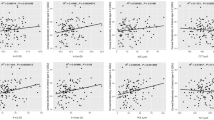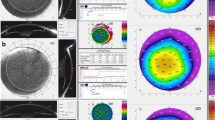Abstract
Purpose
We aimed to explore a new classification system based on the change of focal corneal curvatures and corneal thickness in Terrien’s corneal degeneration with optical coherence tomography.
Methods
This was a cross-sectional study. Ninety eyes of 59 patients with Terrien’s degeneration were examined with slit lamp biomicroscopy, Orbscan II corneal tomography and the Visante OCT system, and were staged according to Süveges’s classification.
Results
The ratio of female to male patients was 1.57:1. The ratio of bilateral to unilateral lesions was 1.27:1. The occurrence of bilateral lesion was higher in males than in females (x2 = 7.791, p = 0.005). There was no difference in the mean age between female and male patients (t = 1.859, p = 0.068), or between patients with bilateral and unilateral lesions (t = 1.797, p = 0.078).The minimum corneal thickness at the thinnest point (MinCT) and anterior curvature of the peripheral cornea were almost normal in the initial stages of disease. The anterior curvature was flattened when MinCT became less than 0.56 mm, returned to normal when MinCT was no more than 0.24 mm, and bowed forward when MinCT was no more than 0.13 mm. The posterior corneal curvatures were bowed forward from their normal curvatures in 42 of 90 eyes when MinCT was no more than 0.41 mm. These eyes’ MinCT ranged from 0 to 0.41 mm. There was a strong correlation between change of corneal curvatures and MinCT (r = −0.943, p < 0.01). A new classification of six stages based on corneal curvatures is proposed for evaluating the development of Terrien’s degeneration. Statistically, there was a moderate correlation between either the Süveges staging or the new staging and the width and circumference of corneal lesions, visual acuity, and simulated keratometric value (all r < 0.6). The correlation of MinCT with the new classification based on corneal curvatures was higher than that with Süveges’s classification (r 1 vs. r 2 , −0.943 vs. -0.801).
Conclusion
The proposed new classification based on focal corneal curvatures is closely associated with corneal thinning, is valuable for evaluating the development of Terrien’s degeneration and may enhance surgical planning.




Similar content being viewed by others
References
Guyer DR, Barraquer J, McDonnell PJ, Green WR (1987) Terrien’s marginal degeneration: clinicopathologic case reports. Graefes Arch Clin Exp Ophthalmol 225:19–27
Iwamoto T, DeVoe AG, Linsy R, Cheng F (1972) Electron microscopy in cases of marginal degeneration of the cornea. Invest Ophthalmol Vis Sci 11:241–256
Süveges I, Levai G, Alberth B (1972) Pathology of Terrien’s disease. Am J Ophthalmol 74:1191–1200
Berrocal AM, Chen PC, Soukiasian SH (2002) Ultrasound biomicroscopy of corneal hydrops in Terrien’s marginal degeneration. Ophthalmic Surg Lasers 33:228–230
Hattori T, Kumakura S, Mori H, Goto H (2013) Depiction of cavity formation in Terrien marginal degeneration by anterior segment optical coherence tomography. Cornea 32:615–618
Cheng CL, Theng JT, Tan DT (2005) Compressive C-shaped lamellar keratoplasty: a surgical alternative for the management of severe astigmatism from peripheral corneal degeneration. Ophthalmology 112:425–430
Liang LY, Liu ZG, Chen JQ, Huang T, Wang ZC, Zou WJ, Chen LS, Zhou SY, Lin AH (2008) Keratoplasty in the management of Terrien’s marginal degeneration. Zhonghua Yan Ke Za Zhi 44:116–121
Li Y, Shekhar R, Huang D (2006) Corneal pachymetry mapping with high-speed optical coherence tomography. Ophthalmology 113:792–799
Li Y, Meisler DM, Tang M, Lu AT, Thakrar V, Reiser BJ, Huang D (2008) Keratoconus diagnosis with optical coherence tomography pachymetry mapping. Ophthalmology 115:2159–2166
Lim LS, Aung HT, Aung T, Tan DT (2008) Corneal imaging with anterior segment optical coherence tomography for lamellar keratoplasty procedures. Am J Ophthalmol 145:81–90
Nguyen P, Chopra V (2013) Applications of optical coherence tomography in cataract surgery. Curr Opin Ophthalmol 24:47–52
Torres LF, Saez-Espinola F, Colina JM, Retchkiman M, Patel MR, Agurto R, Garcia G, Diaz JL, Huang D, Schanzlin DJ, Chayet AS (2006) In vivo architectural analysis of 3.2 mm clear corneal incisions for phacoemulsification using optical coherence tomography. J Cataract Refract Surg 32:1820–1826
Tan AN, Sauren LD, de Brabander J, Berendschot TT, Passos VL, Webers CA, Nuijts RM, Beckers HJ (2011) Reproducibility of anterior chamber angle measurements with anterior segment optical coherence tomography. Invest Ophthalmol Vis Sci 52:2095–2099
Duke-Elder S (1965) System of Ophthalmology, vol 8, part 2. H. Kimpton, London
Acknowledgments
This study was supported in part by “Guangdong Scientific Program 2012” in China (Grant number: 2012B010300010 and 2011B0318000295) and National Institutes of Health Grant EY018184 in the United States.
Conflict of interest statement
All authors except Dr. David Huang certify that they have NO affiliations with or involvement in any organization or entity with any financial interest (such as honoraria; educational grants; participation in speakers’ bureaus; membership, employment, consultancies, stock ownership, or other equity interest; and expert testimony or patent-licensing arrangements), or non-financial interest (such as personal or professional relationships, affiliations, knowledge or beliefs) in the subject matter or materials discussed in this manuscript.
Dr. D. Huang receives a royalty from an optical coherence tomography-related patent licensed to Carl Zeiss Meditec by the Massachusetts Institute of Technology. Dr. D. Huang has a significant financial interest in Optovue, a company that may have a commercial interest in the results of this research and technology. This potential individual conflict of interest has been reviewed and managed by OHSU.
Author information
Authors and Affiliations
Corresponding author
Additional information
Ning Wang, Chun-xiao Wang, Xiu-fen Lian and Su-juan Duan contributed equally to this work.
Rights and permissions
About this article
Cite this article
Wang, N., Wang, Cx., Lian, Xf. et al. Staging of development in Terrien’s degeneration based on corneal curvatures detected by optical coherence tomography. Graefes Arch Clin Exp Ophthalmol 253, 1757–1764 (2015). https://doi.org/10.1007/s00417-015-3057-4
Received:
Revised:
Accepted:
Published:
Issue Date:
DOI: https://doi.org/10.1007/s00417-015-3057-4




